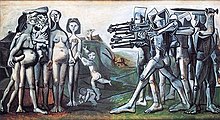
Pablo Picasso, Massacre in Korea, 1951
In 1944 Picasso joined the French Communist Party, attended an international peace conference in Poland, and in 1950 received the Lenin Peace Prize from the Soviet government.[21] But party criticism of a portrait of Stalin as insufficiently realistic cooled Picasso’s interest in communist politics, though he remained a loyal member of the Communist Party until his death. In a 1945 interview with Jerome Seckler, Picasso stated: “I am a Communist and my painting is Communist painting. ... But if I were a shoemaker, Royalist or Communist or anything else, I would not necessarily hammer my shoes in a special way to show my politics.”[22] His Communist militancy, not uncommon among intellectuals and artists at the time although it was officially banned in Francoist Spain, has long been the subject of some controversy; a notable source or demonstration thereof was a sarcastic quote commonly attributed to Salvador Dalí (with whom Picasso had a rather strained relationship[23]), ostensibly casting doubt on the true honesty of his political allegiances:
- Picasso es pintor, yo también; [...] Picasso es español, yo también; Picasso es comunista, yo tampoco.
- (Picasso is a painter, so am I; [...] Picasso is a Spaniard, so am I; Picasso is a communist, neither am I.) [24][25][26][27][28][29]
He was against the intervention of the United Nations and the United States[31] in the Korean War and he depicted it in Massacre in Korea. In 1962, he received the International Lenin Peace Prize.
0 comments:
Post a Comment